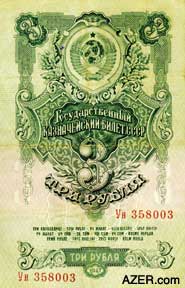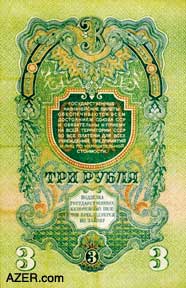|

Summer 2004 (12.2)
Pages
82-85
Baku Baron Days
Foreign
Investment in Azerbaijan's Oil
by Mir Yusif Mir-Babayev
  The
dramatic development of the oil business on the Absheron Peninsula
during the late 19th and early 20th centuries made Baku the main
industrial center in the Caucasus. This growth of oil production
in Baku was based upon high quality crude oil, cheap available
manpower, and the unusually quick and effective development and
implementation of technical improvements. The
dramatic development of the oil business on the Absheron Peninsula
during the late 19th and early 20th centuries made Baku the main
industrial center in the Caucasus. This growth of oil production
in Baku was based upon high quality crude oil, cheap available
manpower, and the unusually quick and effective development and
implementation of technical improvements.
In 1898, the Azerbaijani oil industry exceeded the U.S. oil production
level. At that time, approximately 8 million tons were being
produced. In 1901, Baku produced more than half of the world's
oil (11 million tons), and 95 percent of all Russian oil. Approximately
1.2 million tons of Baku kerosene were also sold abroad.
The main oil-producing regions were located near Baku at Sabunchi,
Surakhani and Bibi-Heybat. Until the beginning of the 20th century,
the Sabunchi region was producing 35 percent of Baku's oil, and
the Bibi-Heybat region produced 28 percent, followed by the Ramani
and the Balakhani regions.
Blowouts made up the main portion of all oil production in the
early days although this was a very uneconomical and environmentally
harmful process. However, blowout production decreased as the
equipment was improved. In 1887 blowouts accounted for 42 percent
of the recovered oil, but in 1890 it had decreased to 10.5 percent.
Photos: Currency notes and bond notes of the
Oil Baron period and early Soviet period. Note, for example the
numerous languages and scripts in which they were printed, such
as Russian, Azeri in Cyrillic and sometimes Arabic script.
The foreign capital inflow to
Baku increased toward the end of the 19th and the beginning of
the 20th centuries (Nobels, Rothschilds, Vishau and others).
Naturally, the increased capital led to a significant increase
in oil production, and the rapid growth of industries supplying
services to the oilfield and oil-refining sectors, such as the
building of new ports and electric power stations.
At that time, Baku ranked third in the Russian Empire after St.
Petersburg and Moscow in relation to electric power plant output.
Five percent of the electricity being produced was used for lighting
and 95 percent was being used by industrial enterprises.
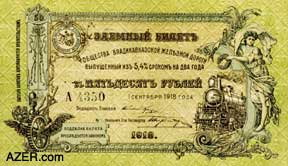  In order
to provide services to the expanding oil fields, the following
joint stock companies were established: the Caspian Engineering
and Boiler Plant, the engineering shops of the Brothers Nobel,
S.M. Shibayev & Co., Caucasus & Mercury, Caspian Engineering
Plant & Ironworks, Nadezhda Association, Orient Warehouses
Association, Dadashev's Dockyard and various others. More than
half of the engineering plants that appeared were used primarily
for repairing ships as sea was the primary means of oil transportation. In order
to provide services to the expanding oil fields, the following
joint stock companies were established: the Caspian Engineering
and Boiler Plant, the engineering shops of the Brothers Nobel,
S.M. Shibayev & Co., Caucasus & Mercury, Caspian Engineering
Plant & Ironworks, Nadezhda Association, Orient Warehouses
Association, Dadashev's Dockyard and various others. More than
half of the engineering plants that appeared were used primarily
for repairing ships as sea was the primary means of oil transportation.
During the last quarter of the 20th century, the Czarist government
encouraged the foreign investment in the oil industry as agreed
upon in a government resolution adopted on May 1, 1880 at a Special
Meeting devoted to the admittance of foreigners to oil fields
within the Baku region.
Prince M. Golitsyn, the Caucasus Governor-General, at the time
wrote, "The situation in the Caucasus is unique. Without
participation of Russian capitalists, it is difficult to solve.
The lack of free capital, the limited industrial infrastructure,
the low level of agriculture, the lack of technical knowledge
and weak business initiative of the resident population are long
term obstacles to the economic growth of the region. Under such
circumstances, the participation of foreigners in the economy
in the Caucasus should not be rejected. In addition, the prohibition
on purchasing real estate could lead to a stoppage of foreign
capital inflow, and to unavoidable damage to its economic interests."
The Russian Ministers of Finance Sergey Vitte and V. Kokovtsov
also supported the involvement of foreign capital in the Caucasus.
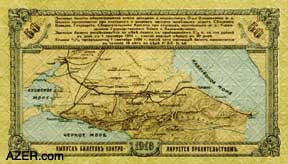  Around
1901, foreign capital took a leading position in the production
and sale of Russian oil products. British companies were very
active; they invested about 60 million golden rubles in Baku
oil business from 1898 to 1903 (though they had already shown
interest in Baku oil business much earlier). This was a considerable
sum for that day. Around
1901, foreign capital took a leading position in the production
and sale of Russian oil products. British companies were very
active; they invested about 60 million golden rubles in Baku
oil business from 1898 to 1903 (though they had already shown
interest in Baku oil business much earlier). This was a considerable
sum for that day.
The British
The director of an English-Russian trade company, I. Hunway,
visited Baku with the aim of conducting his own study to find
out the condition of the Baku oil sources in 1741. In 1762, he
published a book, "Historical Studies of English Trade on
the Caspian Sea", which included a detailed description
regarding the Baku oil business. Specifically, Hunway wrote that
Baku's residence had been using gas for boiling water, cooking
and burning lime, for quite some time.
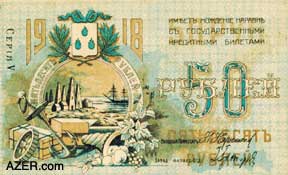  Having
visited Baku in 1784, another English traveler G. Foster wrote
that the people in Baku used thick black oil to cover the roofs
of their houses to protect against leaks. Having
visited Baku in 1784, another English traveler G. Foster wrote
that the people in Baku used thick black oil to cover the roofs
of their houses to protect against leaks.
In 1884, Secretary of the London Oil Association Boverton, is
quoted at a meeting of the Chemical Industry Society, as saying,
"Baku's oil sources are so extensive that the Russians could
supply the whole world with kerosene and oil." [Mining Journal,
1885, v.1, p. 349].
In 1885, the British magazine, Engineering, published a major
article summarizing the growth of the Baku oil industry from
1864. It stated: "Within two or three years Russia will
be able to gain control over the markets in Northern Europe.
In the near future, Baku will be a strong competitor of the U.S.
in countries bordering the Black and Mediterranean seas, not
to mention, the Far East and India" [Trade Sheet, 1886,
22nd February].
Charles Marvin a British traveler and writer reached a similar
conclusion about the competitive activity between the two countries.
Marvin wrote "Baku is the Oil of Europe" and "Region
of Eternal Fire: The Petroleum Region of the Caspian", a
book which was published three times, the latest being in 1891.
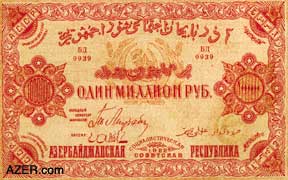  Left: One million rubles. Early Soviet period (1922).
Russian and Azeri in Arabic script. Left: One million rubles. Early Soviet period (1922).
Russian and Azeri in Arabic script.
Having studied the extent of the oil pools of the Caucasus, Marvin
wrote in his leaflet "The Future Flow of Russian Oil"
that sooner or later America would yield its leadership to Russia.
Marvin also mentioned that the Russian oil business was too attractive
for England to allow it to slip out of its hands.
In order to make deeper inroads into the Baku oil business, he
advised implementation of the construction of the Baku-Batumi
(Georgia) Oil Pipeline. Construction began in 1897 and was completed
exactly 10 years later.
Many engineers, scientists and businessmen were staunch supporters
of the rapid construction of the Baku-Batumi Oil Pipeline, including
Dmitry Mendeleyev, Haji Zeynalabdin Taghiyev, Alfonse Rothschild,
the Nobel Brothers, I.P. Ilimov, S.I. Baghirov and others.
As a patriot of his country, Marvin believed that the Russian
oil pipeline, together with all necessary equipment, machinery,
pumps, reservoirs and other facilities, would fall into German
or Belgian hands [Mining Magazine, 1887, V1].
The British company John Russell & Co. sent representatives
to the Caucasus twice in 1886. Stuart, a representative of the
London Chamber of Commerce, and Peekock, the English Vice Consul
in Batumi, were present at the Third Session of the Baku oil-producers
held in March-April 1886. In his report, Stuart came out against
the purchase of kerosene plants by the English. He believed that
Great Britain should focus their main attention on trading in
oil products.
Nevertheless, the oil fields of S.M. Shibayev, located in Ramani
(a district outside of Baku), which were purchased by James Vishau
in 1890, yielded 1 million rubles of net profit a year.
Taghiyev
English businessmen bought Taghiyev's fields for 5 million rubles
in 1897. In two and a half years, they had earned more than 7.5
million rubles in net profit.
In 1904, Baku kerosene supplied 47 percent of the needs of Britain,
and 71 percent of the needs of France. It should be mentioned
that Taghiyev sold his oil companies in order to diversify into
other industries of the Azerbaijani economy. Meanwhile, he amassed
shares in the Oleum Company established on the basis of these
enterprises to the amount of 16 million rubles. This allowed
him to continue accumulating capital created in the oil sector.
During this period, Taghiyev invested significant sums into the
textile, food, construction and shipbuilding industries, as well
as in fishery. Later, in 1890, Taghiyev bought the Caspian Steamship
Company, renovating it, and then creating a fleet of 10 steamboats.
Taghiyev's company (1872-1897) was a diversified business. His
largest oil companies were fourth in terms of oil output, preceded
by the Brothers Nobel and the Caspian Partnership. In 1885, his
company produced some 7 million poods of oil and 2 million poods
of kerosene. [Note: pood is a Russian unit of weight equivalent
to about 36.11 pounds.]
Naghiyev and Asadullayev
The companies owned by Musa Naghiyev and Shamsi Asadullayev were
the largest Baku oil producers. Established in Baku respectively
in 1887 and 1893, they produced between 7-12 million poods of
oil annually. These companies owned oil fields, oil distilleries
and oil tankers.
Musa Naghiyev's company had fixed capital at 10 million rubles
in 1907. Between 1904 and 1910, it ranked as the 6th or 7th largest
oil company in Russia. Both companies owned by Naghiyev and Asadullayev
held 10 votes in the Council of the Baku Oil Producers, which
provides evidence in itself as to the importance of these companies.
The largest oil company in Russia, The Nobel Brothers, held 18
votes in this Council in 1914.
Council of Oil
Producers
The first session of the Baku Oil Producers was called in 1884
and it continued for 34 sessions. The Council provided the basis
for these sessions. The representatives of the largest joint
stock companies were elected as the Council's members. The main
goals of the Council included (1) protection of the oil-producers'
interests in government bodies, (2) provision of high profits
to the oil magnates, and (3) the establishment of opposition
to the labor movement. The Council was headed by Ludwig Nobel
who was the older brother of Alfred Nobel who went on to establish
the Nobel Prize. He held this position until 1888.
The Council issued the Oil Business Magazine (published in Baku
from 1898-1920). It was one of the first periodicals in Russian
about the Russian oil business. Since May 1920 when the Bolsheviks
took power in Baku until the present day, the Azerbaijan Oil
Business magazine has been published.
John D. Rockerfeller
The increasing interest of John D. Rockefeller's syndicate to
export Baku oil products resulted in intense competition on the
Absheron oil market. This incited foreign entrepreneurs, who
had earlier put down roots in the local market, to struggle actively
for the leadership.
The Standard Oil syndicate sent petroleum geologists to the Shamakhi
region of Azerbaijan in 1898. Having surveyed the region, they
came to the conclusion about the viability of the commercial
oil reserves. In 1902, John D. Rockefeller, was so eager to get
involved with oil fields in the Caucasus that he was prepared
to turn down a profitable deal that the Japanese were offering
in preference to the Caucasus.
The idea to purchase Baku's oil fields in association with banks
in St. Petersburg with a production output of nearly a third
of all Russian's oil production was included in Standard Oil's
project for participation in the Russian oil business (1903).
This project was never realized, but Rockefeller continued to
suggest other projects [See Oil Business, November 5, 1903].
As of January 1, 1916, the four main companies, which led the
Baku oil industry included the Nobel Brothers; Russian General
Corporation Oil; Transnational Trust Royal Dutch Shell, and the
financial oil corporation Neft [See the Review of the Baku Oil
Industry for 1915, Baku, v. 2, 1916, pp. 235-331].
Nobel Brothers
The Nobel Brothers Petroleum Company was an oil-producing company
established in St. Petersburg in 1879. The primary owners were
Ludwig, Robert and Alfred Nobel. On April 10, 1902, the company
signed a contract for the purchase of oil fields in Romany, which
were owned by the oil producer Isabey Hajinsky. On October 17,
1905, in accordance with the Committee of Ministers, the company
purchased the oil fields owned by oil producer A. Adamov. The
company's fixed capital in 1914-1917 was 30 million rubles. By
1916, it was the largest oil company in Russia, producing 76
million poods of oil. The Russian General Corporation Oil, established
in London in 1912 by the most important Russian and foreign banks,
united 20 companies.
These included A.I. Mantashev & Co., G.M. Lianosov &
Sons, Moscow-Caucasus Trade Company, Caspian Partnership, Russian
Petroleum Society, Absheron Petroleum Society and others. The
fixed capital in oil in 1914 was 23 million rubles. By 1917 it
had increased to 125 million rubles under the management of the
Russian-Asian Bank. Russian oil production in 1914 was distributed
among Oil (28%), Shell (20%), and the Nobel Brothers (14%). These
monopolies produced 62 percent of the world's oil, and two thirds
of its kerosene and black oil.
Shell
Shell was established on October 18, 1897 by Marcus Samuel Jr.
Ranked one of the largest British oil companies in Baku, it owned
30 ocean-going ships, and more than 340 oil terminals located
between Baku to Shanghai. Altogether, up to the beginning of
the 20th century, British oil producers took on the management
of more than 11 percent of the Baku oil fields. Unlike in the
Russian oil industry, where the Nobel Brothers were the main
competitor to Shell, on the world scene this part was played
by the U.S. syndicate Standard Oil. Shell always competed with
the latter for a monopoly on the world market. Baku oil products
were dominant among the goods sold by the company.
In 1907, with the aim of uniting efforts in competition with
the U.S. syndicate, two large companies, Shell and Royal Dutch,
merged into the transnational trust Royal Dutch Shell, headed
by Henry Deterding. At that time 60 percent of the company's
shares were owned by Royal, while 40 percent were owned by Shell.
The trust united the following companies: the Caspian Black Sea
Society, Caucasus, S.M. Shibayev, and Souchastniki. Oil companies
in the trust produced a fifth of Russian output up to 1914. Royal
Dutch Shell's output from the Baku oil fields was 57 million
poods in 1914.
The Royal Dutch trust had its own pipelines, a large number of
refineries, oil tankers with a total capacity of 1.6 million
tons and a diversified trade network. The capital stock of the
trust amounted to more than 2.5 billion rubles. Deterding was
called "The Napoleon of Oil" by his contemporaries.
Oil production by the trust was 15.5 million tons in 1926.
A member of the trust, the Caspian Black Sea Society, established
in 1883 by A. Rothschild, was the main exporter of oil products.
This company sold 36 percent of total exports, compared with
the Nobel Brothers, which sold 18 percent. The remaining exports
were distributed among other exporters.
The Review of Factories and Plants of the Transcaucasian Region
contains a list of foreign kerosene and lubricating oils supplied
by Rothschild's Caspian-Black Sea Society. It includes Great
Britain, France, Austria, Belgium, Turkey, Greece, Germany, Italy,
Holland, Portugal, Malta, Danube principalities, Japan, China,
Algeria, Indochina and the Philippines. Altogether, the Rothschilds
exported 27,600 poods of kerosene from
Baku through Batumi.
The financial oil corporation Neft (established in St. Petersburg
in 1883) was a Russian company involved in the production, transportation,
storage and trading of oil products. Its fixed capital in 1916
was 33 million rubles, and it was managed by the Russian-Asian
and the Petrograd Discount and Loan Bank. The corporation owned
oil fields, kerosene and chemical plants in Baku, and united
the companies Baku Petroleum Society, Neft, Balakhani-Zabrat
Society and others.
Foreign Investment
The total amount of foreign currency invested in the Baku oil
industry up to 1917 averaged 111 million rubles; 60 percent of
oil production in Russia was managed by foreign companies, while
75 percent of the trade in oil products was under the management
of foreign companies.
According to several documents, until 1920 foreigners, including
businessmen from Great Britain, France, the USA, Sweden and Germany,
made about 70 percent of the investment in the Baku oil industry.
During World War I, the capitalist system was characterized by
the predominance of monopoly cartels formed of the largest entrepreneurs.
Furthermore, the more raw material sources and markets united
into one monopoly union, the more stable such a union would be.
After World War I, the relationships that had been established
between the Russian monopolies, especially Baku's and the oil
monopolies in Europe and the U.S. were first complicated and
then broken. Tendencies towards strengthening of the labor movement
were noted, resulting in a revolt.
In the long term, the historical events of 1917 in Russia stopped
any further expansion of foreign capital into the Baku oil industry.
In March 1918, the power of the workers and peasants was established,
and on June 2, 1918, a decree was published which declared the
Russian oil industry to be the property of the people.
On 24th May 1924, the Azerbaijan Revolutionary Committee adopted
a decree on the nationalization of the Azerbaijan oil industry.
In accordance with the decree, all oil producing, refining, oil
trade, and auxiliary enterprises were declared to be the property
of the state. The Oil Committee, created to manage the oil business
in Azerbaijan, liquidated 272 private petroleum companies located
in the Baku region.
Mir-Yusif Mir-Babayev, Doctor
of Chemical Sciences is a Professor at Azerbaijan Technical University.
His articles, "Azerbaijan's Oil History: A Chronology Leading
up to the Soviet Era" (Part 1) and "A Brief Oil Chronology
since 1920" (Part 2) published in AI 10.2 and 11.2 (2002
and 2003). Search at AZER.com.
These articles have now been expanded into a small book entitled
"Brief Chronology of the History of Azerbaijan's Oil Business"
by M.F. Mir-Babayev, Baku: 2004, 200 pp. The book is a summary
of the chronology of the oil business in Azerbaijan from the
9th century through February 2004. Contact author for copies:
mirbabam@bp.com.
Back to Index AI 12.2 (Summer
2004)
AI Home
| Search | Magazine
Choice
| Topics
| AI Store | Contact us
Other Web sites
created by Azerbaijan International
AZgallery.org | AZERI.org | HAJIBEYOV.com
|


